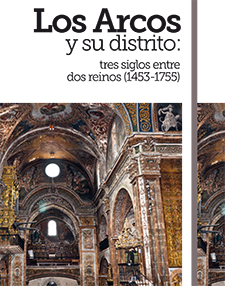LOS ARCOS AND ITS DISTRICT: THREE CENTURIES BETWEEN TWO KINGDOMS (1463-1753)
16 September 2016
The artistic heritage of Torres del Río: much more than the Holy Sepulchre
María Josefa Tarifa Castillo. University of Zaragoza
The Navarrese town of Torres del Río has a rich artistic heritage, mainly made up of religious buildings, which were built throughout the centuries of the Middle Ages average and Modern times. Among them, the Church of the Holy Sepulchre stands out for its exceptional architectural forms, a true jewel of Navarrese Romanesque architecture, to which 20th and 21st century scholars, whether local, national or international, have paid special attention in an attempt to clarify the use and function of the temple, the possible typological model in which it may have been inspired, the masters who may have carried it out and its chronology. Some of the various theories that researchers have developed about this building have to do with its belonging to a religious order, for example, that of the Temple, due to the fact that it is a Romanesque church with an octagonal floor plan, or the Order of St. James, simply because it is on the pilgrimage route to Santiago de Compostela. It has also been alluded to as a possible use as a hospital chapel; in other cases, as a lantern for the dead, for which a fire would burn on the upper part of the small edicule that crowns the temple in memory of the deceased, or it has even been suggested that it could be employee as a beacon for pilgrims to guide walkers on their journey to Galicia or on their way back to their places of origin. It has also been suggested that the building had forms typical of Islamic architecture, as it is covered with a vault of interlaced ribs that leave the central space free and close the lighting openings with various designs of interlaced stone lattices, perhaps made by Moorish or Mozarabic artists, all hypotheses that have been ruled out to date.
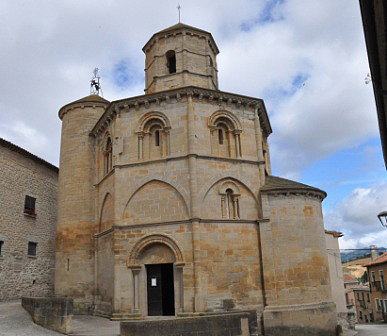
Torres del Río. Church of the Holy Sepulchre
According to the latest programs of study by Javier Martínez de Aguirre, it is known that the unique architectural forms of the church, such as the polygonal central plan and its octagonal elevation divided into three levels, marked by mouldings that run around the entire perimeter of the church, and topped on the roof by another octagonal building of smaller size but similar structure, respond to its main significance, which is the imitation of the Church of the Holy Sepulchre in Jerusalem, the funerary monument par excellence in the Christian world. Therefore, the church at Torres does not literally copy the complete form of model , but rather evokes the Western conception of agreement as a central building with successive levels of superimposed arcades. A Jerosolimitan temple that from the 12th century was liturgically cared for by the Canons of the Holy Sepulchre, an order on which the church in Torreano depended from the outset, as Father Valeriano Ordóñez has already stated. Belonging to this order is also shown by the very ownership of the church in Navarre, whose façade still bears the double-barred cross of the sepulchral canons and the representation of the hierosolimitan building within the capital dedicated to the visit of the holy women at the tomb of Christ. The church is not full of architectural forms of Islamic influence, but of orientalising evocations in terms of a transcription of the Holy Land, which is why the design of the stone lattices of the window interlacing are not Mudejar solutions, but rather traces of the Languedoc tradition and the stone dome with quadrangular ribs that criss-cross, leaving the central octagonal space free, result although it shows evident Andalusian procedures, the ribs are rigged by procedures similar to other 12th-century western vaults and are therefore not the work of a Mudejar stonemasons' group in the service of Christian clients.
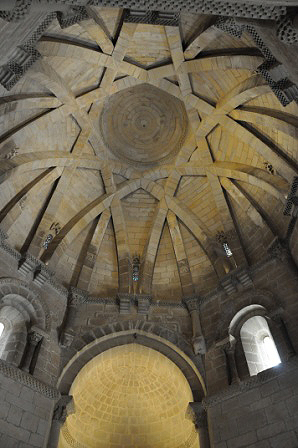
Torres del Río. Church of the Holy Sepulchre
Dome with quadrangular ribs
A temple that, of agreement to the analysis of these architectural forms, and the monumental sculpture that complements it, was built from the last third of the XII century, more concretely of the decades 1160 or 1170, in a single constructive phase, being added immediately after the spiral staircase attached to the west wall of the main octagon that allows the access to the roof. The interior of the building is presided over by the polychrome wood carving of a Romanesque Crucified Christ, dated by Clara Fernández-Ladreda in the third decade of the 13th century, placed on a wooden cross with the ends finished in florenzados ornaments. It is of a dead Christ with four nails, semi-naked, covered with the cloth of purity knotted on the side and with the edge falling diagonally, an image that carries on its head a royal crown, symbol of the triumph of Jesus Christ over death.The town of Torres also had another building of worship since medieval times, the parish church of San Andrés, which thanks to the economic boom and population increase experienced in the early sixteenth century, was built again on the site of the previous, but larger to accommodate the growing parishioners. A temple of Latin cross plan, formed by a nave of two sections, Wayside Cross protruding in plan and polygonal chevet of three straight panels, erected with well carved stone ashlars and overturned with simple vaults of ribs of terceletes, which in some cases draw a quatrefoil around core topic polar. The building was probably completed at the beginning of the third third third of the 500s, and in which Tarifa Castilla reveals the hitherto unknown intervention of local master masons, such as Juan de Larrea, who lived in Torralba, or the Torreano Pedro Remírez. At the end of the 500s and beginning of the 600s, the tower with a high prismatic shaft was built attached to the right side of the nave, contracted by Juan de Larrañaga, a stonemason from Estella, as the authors of the Catalog Monumental de Navarra noted. The upper part is topped by a bell tower that echoes the classicist language prevailing in those years of pure lines and ornamental austerity, spread from the Escorial focus to the entire peninsular territory starting in the last third of the 16th century. Finally, in the 1730s the existing sacristy was replaced by another baroque one, designed by Ignacio Labayen, inside which there was a wooden chest of drawers made in 1737 by Juan José de Mendoza, master of Santa Cruz de Campezo (Álava), with the typical geometric work of the time carved on its front, furniture that is still in use today.
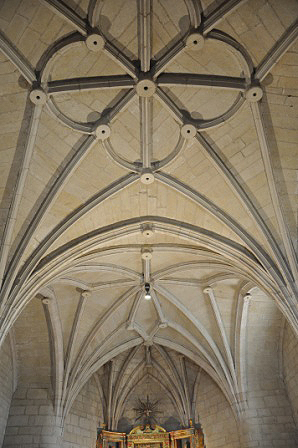
Torres del Río. Parish Church of San Andrés
Ribbed vaults
A A temple that in the 17th century was endowed with an important artistic adornment, of which the main altarpiece dedicated to the patron saint, a Baroque work from a workshop in La Rioja, which Pedro Jiménez headed in Logroño in 1637 when he was contracted, is a piece of art. An artist trained in the prestigious Valladolid workshop of Gregorio Fernández, with whom he was working as a journeyman in 1610. According to the authors of the Catalog Monumental de Navarra, his son Pedro Ximénez Castrejana may also have been involved in this altarpiece, in which the sculptor Juan de Urra, neighbor of Viana, and the painter Andrés de Gauna, who undertook its polychromy, also collaborated.
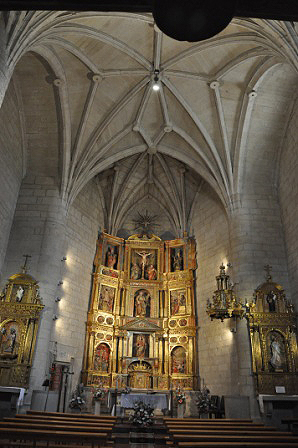
Armañanzas. Parish Church of San Andrés
High altarpiece and collaterals
The altarpiece, raised on a stone pedestal with recesses, is architecturally composed of a bench and two sections that are divided into three sections, articulated by composite columns, the shafts of which have grooves in the lower third of the first section and vertical grooves in the second section. The central street stands out for the pairs of columns that frame it and also for the large triangular pediment that crowns the box of the lower section. The two floors are separated by friezes, the front of which is decorated in relief with vegetal motifs surrounded by scrolls. The altarpiece culminates in an attic crowned in its central part by a curved split pediment ending in scrolls.
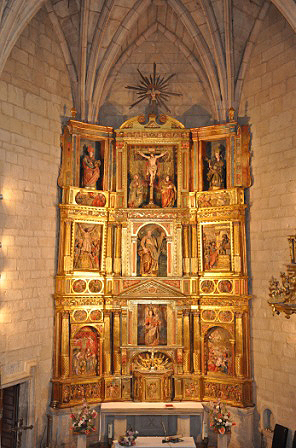
Torres del Río. Parish Church of San Andrés
High altarpiece. Pedro Jiménez, 1637
The iconographic programme of the altarpiece is expressed through an alternation of reliefs and bultos, the latter being reserved for the central street and the attic. On the bench there are reliefs of Saint Michael the Archangel defeating the devil, and scenes from the Passion of Christ, such as the Arrest, the Flagellation, the Crowning of Thorns and Christ on the Way to Calvary, and the representation of the Guardian Archangel. The centre of the bench is occupied by the Tabernacle Exhibitor, on the door of which the Eucharistic Saviour is carved in relief, accompanied on the sides by the round figures of the apostles St. Peter and St. Paul. The first section of the altarpiece is dedicated to the Virgin, and for this reason the most well-known and outstanding passages from her life were carved, such as the Annunciation on the left and the Nativity on the right, which are the centrepiece of the round sculpture of the Virgin Mary with the Child. Above these Marian reliefs are four ovals with female figures that are allegories of the theological virtues of Faith, holding the chalice and the Sacred Host, Hope, with the anchor in her hands, and Charity, protecting some children, accompanied by the representation of the cardinal virtue of Temperance, depicted as a woman pouring the liquid contents from one container to another in a measured manner.
The second section of the altarpiece is centred on the titular figure of the church, Saint Andrew, whose round figure occupies the central niche, represented as a mature man with wavy hair and long beard, standing in contraposto, holding the cross that identifies him with one hand and a book in the other. On both sides are reliefs of the saint's martyrdom, crucified on a cross with a cross that was tied with ropes, and not nailed, to prolong his agony, and the trial to which the apostle was subjected before Aegeas, proconsul of Achaia, who ordered him to be tortured. Above the reliefs of the apostle are two ovals with the reclining figures of the four evangelists accompanied by animal attributes, on the right St Mark with the lion and St John the Evangelist with the eagle, and on the left St Luke with the bull and St Matthew with the angel. The attic is presided over by a Calvary composed of the round figures of the Crucified Christ, the Virgin and Saint John, framed in the side boxes by two holy bishops, one of them identified as Saint Fermin, who are mounted on pedestals with reliefs of the Holy Fathers grouped in pairs, on the left Saint Gregory with the papal mitre and Saint Jerome with the cardinal's hat and the lion, and on the right Saint Ambrose and Saint Augustine. A dove symbolising the Holy Spirit between bursts culminates the ensemble.
In the 1650s, Juan de Zabala, a sculptor from Estella, undertook the two collateral altarpieces located in the arms of Wayside Cross, in the same classicist Baroque language as the main altarpiece, which were valued by Andrés de Larrea, a resident of Viana, and Juan de Urra at 414 ducats. These altarpieces were originally dedicated to Our Lady and Saint Sebastian, although today they house modern round carvings, the northern one with the sculptures of Saint Joseph with the Child and the Virgin of Carmen, and the southern one with the Immaculate Conception and Saint Anthony with the Child.
Also preserved next to the presbytery is an 18th century Baroque loudspeaker, and at the foot of the nave under the choir arch are modern images of Saint Francis Xavier, the Heart of Jesus and the Sorrowful Virgin.
For its part, at the beginning of the 17th century, the Brotherhood of the Vera Cruz commissioned a three-nailed Baroque polychrome wooden crucifix, known as the Christ of the Tree, due to the shape of the unhewn trunk that characterises its cross, a medium-sized image that is currently kept in the sacristy. From the walls of this room also hangs a painted ex-voto narrating the miracle of the healing of the sight of Francisca González, a resident of Bargota, who in 1671 arrived at the church blind and after worshipping the holy cross with its double crossbeam that was venerated there, recovered her sight.
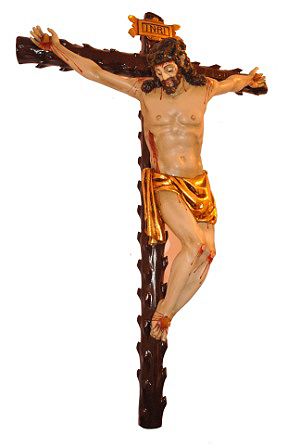
Torres del Río. Parish Church of San Andrés
Christ of the tree. Early 17th century
The economic boom that the town experienced in the Baroque centuries is also evident in the different noble houses that were built in its irregularly laid out urban centre, most of them located along the main street, erected with well-carved stone ashlars and presided over by the coat of arms that proclaimed the privileged social status of their owners.
PROGRAM
Wednesday, 14th September
Between Navarre and Castile (1463-1753)
D. Roman Felones Morrás. Lecturer in History of Art at classroom de la Experiencia. Public University of Navarra
Tasting and savouring: the arts at the service of the senses in the parish church of Los Arcos
D. Ricardo Fernández Gracia. University of Navarra
Thursday, 15th September
Another jewel of the Renaissance in Navarre: the altarpiece of San Andres de El Busto
D. Pedro Luis Echeverría Goñi. University of the Basque Country
Stone and stonework at the service of the Church and the nobility in Sansol
Ms. Pilar Andueza Unanua. University of La Rioja
Friday, 16th September
Armañanzas: in the footsteps of its church, altarpieces and emblazoned houses
José Javier Azanza López. University of Navarra
The artistic heritage of Torres del Río: much more than the Santo Sepulcro (Holy Sepulchre)
María Josefa Tarifa Castilla. University of Zaragoza
Saturday, 17th September
visit Guided tour to Torres del Río, Armañanzas, Sansol, El Busto and Los Arcos.

